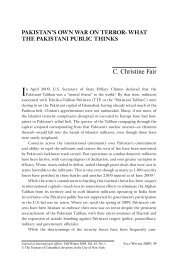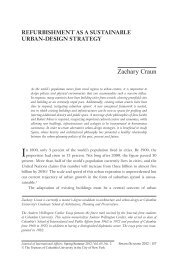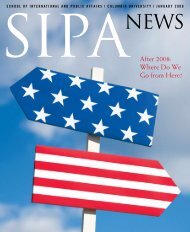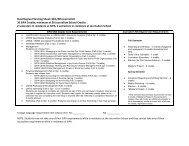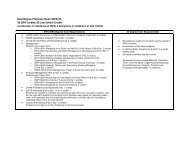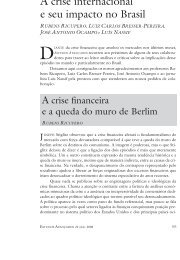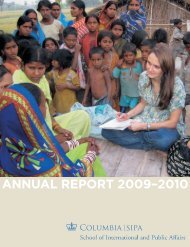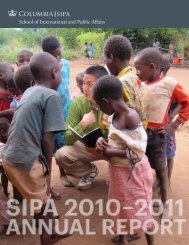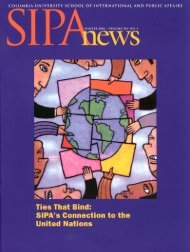SIPA NEWS - School of International and Public Affairs - Columbia ...
SIPA NEWS - School of International and Public Affairs - Columbia ...
SIPA NEWS - School of International and Public Affairs - Columbia ...
Create successful ePaper yourself
Turn your PDF publications into a flip-book with our unique Google optimized e-Paper software.
Exhibit Showcases Rare<br />
African Currencies<br />
Mike Hickman<br />
<strong>SIPA</strong> News writer<br />
The Rotunda at <strong>Columbia</strong>’s<br />
Low Library last<br />
March became the temporary<br />
home for a rare<br />
collection <strong>of</strong> iron <strong>and</strong><br />
copper currencies from<br />
Central <strong>and</strong> West Africa. Only in the<br />
last 20 years have these metal pieces<br />
been recognized within art circles as an<br />
important part <strong>of</strong> African history.<br />
The exhibit was sponsored by<br />
<strong>SIPA</strong>’s Institute <strong>of</strong> African Studies,<br />
<strong>Columbia</strong> University Libraries, <strong>and</strong><br />
appropriately enough, Citibank <strong>and</strong><br />
Chase Manhattan Bank. The 200-<br />
piece collection <strong>of</strong> tools, weapons,<br />
musical instruments, ornaments,<br />
objects <strong>of</strong> prestige <strong>and</strong> ingots revealed<br />
the intrinsic value that iron <strong>and</strong> copper<br />
have had in hundreds <strong>of</strong> African societies<br />
since 500 A.D.<br />
The pieces were loaned to the<br />
Institute by Philip Gould, who curated<br />
the exhibit. Gould is an art collector<br />
<strong>and</strong> pr<strong>of</strong>essor emeritus <strong>of</strong> art history at<br />
Sarah Lawrence College in Bronxville,<br />
New York. According to Gould,<br />
Africans liked to use iron <strong>and</strong> copper<br />
pieces as instruments <strong>of</strong> exchange<br />
because they could always be recast<br />
into other objects.<br />
“These currencies come in all<br />
shapes <strong>and</strong> sizes <strong>and</strong> most <strong>of</strong> the<br />
objects were easily recognized as symbols,”<br />
Gould said. “But the relationship<br />
was so close that the actual object<br />
<strong>and</strong> the currency were interchangeable.”<br />
In conjunction with the exhibit,<br />
the Institute held a workshop for<br />
Harlem-area teachers. The event was<br />
led by the Institute’s outreach coordinator,<br />
Paulette Young, <strong>and</strong> Aissata<br />
Sidikou, a lecturer <strong>of</strong> Pan-African<br />
Studies at Barnard College. Both<br />
focused on the many uses <strong>of</strong> African<br />
iron <strong>and</strong> copper currencies <strong>and</strong> the<br />
central role <strong>of</strong> the blacksmith in<br />
African communities past <strong>and</strong> present.<br />
“Traditional African societies<br />
were influenced by various factors both<br />
internal <strong>and</strong> external,” said Young.<br />
“The exhibit <strong>and</strong> writings on the subject<br />
by African scholars are a good way<br />
to teach students that African nations<br />
did not operate in a vacuum.”<br />
Iron <strong>and</strong> copper currencies continued<br />
in use among some African<br />
nations until the 1960s, when they<br />
were ab<strong>and</strong>oned in favor <strong>of</strong> paper <strong>and</strong><br />
coin money. Since then they have<br />
become increasingly popular among<br />
art collectors <strong>and</strong> dealers. Today, these<br />
metals still symbolize power <strong>and</strong> freedom<br />
to many Africans.<br />
“It’s an area that people really<br />
don’t know about,” Young told the<br />
Paulette Young, outreach coordinator for<br />
the Institute <strong>of</strong> African Studies, <strong>and</strong> Low<br />
Library currency exhibit.<br />
approximately 20 teachers who<br />
attended the workshop.<br />
At the workshop, teachers peered<br />
curiously inside glass display cases at<br />
elaborately carved hoes, shovels, <strong>and</strong><br />
iron spears. Malene Hawkins, who<br />
teaches seventh graders at Frederick<br />
Douglass Academy in Harlem, planned<br />
to bring her students to the exhibit<br />
during their studies <strong>of</strong> ancient African<br />
societies. Teacher Curtis Lawrence said<br />
the workshop will help him strengthen<br />
the Africa content <strong>of</strong> his seventh-grade<br />
history classes at the Academy.<br />
The Low Library exhibit closed<br />
on April 15, but another, smaller<br />
exhibit <strong>of</strong> traditional African money is<br />
on display through July 23 at the<br />
Smithsonian’s National Museum <strong>of</strong><br />
African Art in Washington, D.C.<br />
S I P A n e w s<br />
9






